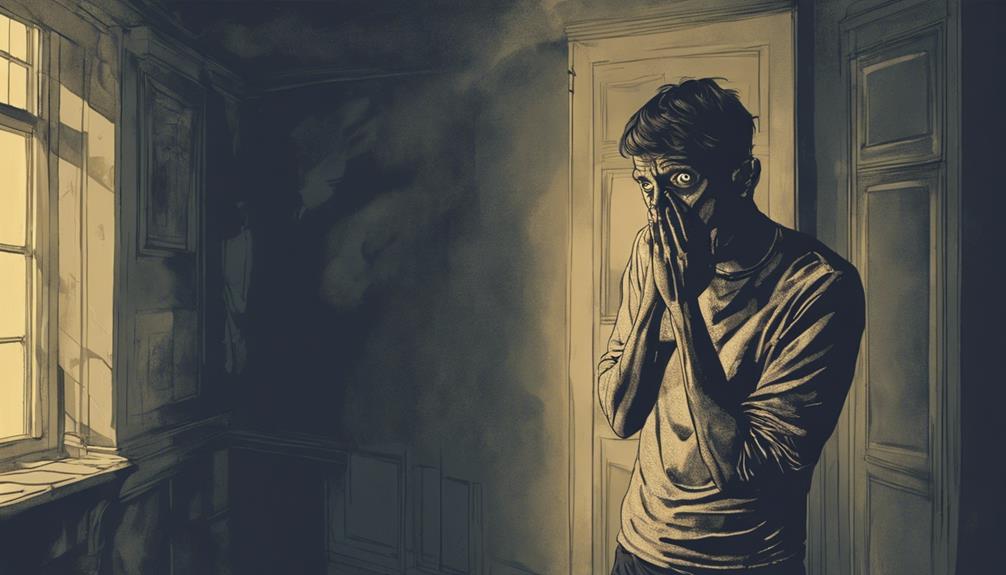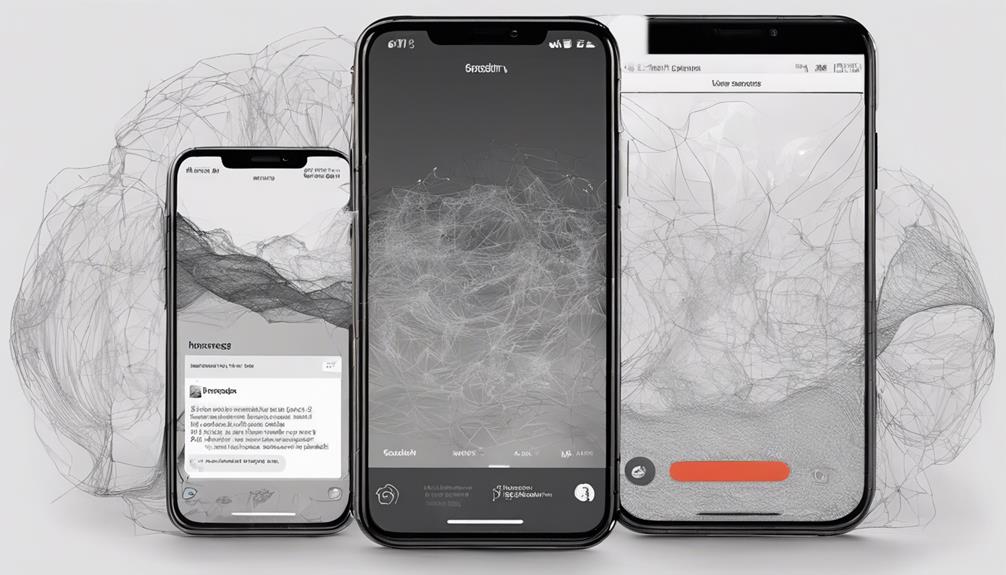Coincidentally, have you ever noticed how a narcissist's tears seem to flow at just the right moments, almost as if on cue?
The triggers behind a narcissist's fake crying behavior are multifaceted and intriguing. From unraveling the complexities of their manipulative tactics to understanding the underlying psychological dynamics at play, exploring the intricacies of what prompts this behavior can shed light on the intricate web of a narcissist's emotional manipulation.
Key Takeaways
- Criticism, rejection, or flaws expose prompts fake crying in narcissists.
- Fake tears serve to regain power, seek attention, and maintain control.
- Narcissists use fake crying to deflect accountability and manipulate situations.
- Feigning tears helps narcissists avoid exposure, seek validation, and control narratives.
Triggers for Narcissist's Fake Crying
When exploring the triggers for a narcissist's fake crying, it becomes evident that these manipulative displays often stem from a perceived threat to their self-image or sense of superiority. Narcissists, with their fragile egos, resort to fake crying as a tool for manipulation and control.
Criticism, rejection, or any exposure of their flaws can act as triggers, prompting them to feign tears in an attempt to regain power in a situation. This behavior is driven by a deep-seated need for narcissistic supply and attention, which they fear losing if their facade is shattered.
Events Provoking Narcissist's Fake Tears

In certain circumstances that challenge their self-image or perceived superiority, narcissists may resort to fake crying as a manipulative tactic to maintain control and garner sympathy from others. When events threaten their ego or sense of superiority, narcissists may engage in fake tears to manipulate those around them.
Here are four scenarios that can provoke a narcissist's fake crying behavior:
- Criticism: Facing criticism can bruise a narcissist's fragile ego, prompting them to use fake tears to deflect accountability and seek sympathy.
- Rejection: Narcissists struggle with rejection as it undermines their self-perceived importance, leading them to fake crying to manipulate others into changing their decisions.
- Challenges to Superiority: Anything that challenges a narcissist's perceived superiority can trigger fake crying as a way to reassert dominance and control in the situation.
- Attention Seeking: When feeling inadequate or overlooked, narcissists may resort to fake crying to draw attention to themselves and evoke sympathy from others.
Circumstances Leading to Fake Crying
Events that challenge a narcissist's self-image or perceived superiority can lead to the manipulation tactic of fake crying as a means to maintain control and solicit sympathy. Fake crying is a tool used by narcissists to manipulate situations, deflect blame, and avoid accountability, all while seeking validation and attention. By shedding crocodile tears, narcissists aim to evoke guilt and sympathy in others, ultimately serving their own interests and reinforcing their facade of superiority or victimhood.
To delve deeper into the circumstances that prompt a narcissist to resort to fake crying, let's examine the following table:
| Circumstances Leading to Fake Crying | Description |
|---|---|
| Feeling of Losing Control | Narcissists may fake cry when they feel their control over a situation slipping away. |
| Challenged Superiority Complex | Instances where their perceived superiority is questioned can trigger fake crying as a defense mechanism. |
| Seeking Attention and Validation | Fake crying helps narcissists draw attention to themselves and seek validation from others. |
| Manipulating to Avoid Accountability | To deflect blame and manipulate situations in their favor, narcissists may resort to fake tears. |
Understanding these triggers can shed light on the manipulative behavior of narcissists when they use fake crying to maintain their control and influence over others.
Situations Sparking Narcissist's Crocodile Tears

Situations that trigger a narcissist's fake crying often revolve around threats to their self-image or reputation. When faced with circumstances challenging their perceived superiority, narcissists may resort to manipulative behaviors such as fake crying to maintain power, deflect blame, or elicit a desired response from others.
Here are four key situations that can spark a narcissist's crocodile tears:
- Seeking sympathy: Narcissists may fake cry to garner sympathy from those around them, manipulating emotions to serve their own needs.
- Attention-seeking: Fake crying allows narcissists to draw attention to themselves, ensuring they remain the center of focus in any situation.
- Control: By feigning tears, narcissists aim to control the narrative and emotions of those present, exerting dominance over the conversation.
- Eliciting a desired response: Whether to avoid accountability or push others to act in a certain way, fake crying is a tool used by narcissists to elicit specific reactions from those in their social circle.
Understanding these triggers can aid in setting boundaries and navigating interactions with narcissistic individuals effectively. It is crucial to recognize that covert narcissist rage triggers can be subtle and may arise from perceived slights or challenges to their superiority, however minor. By identifying these triggers, one can establish strategies to de-escalate potential conflicts or minimize emotional harm. Setting clear boundaries helps protect one’s emotional well-being while minimizing the chances of provoking unnecessary outbursts.
Factors Prompting Narcissist's Fake Emotional Display
Factors prompting a narcissist's fake emotional display often stem from threats to their ego or self-image, leading them to resort to manipulative tactics such as fake crying to serve their self-serving needs. Fake crying serves as a tool for manipulation, allowing narcissists to elicit sympathy or gain control over others.
By feigning tears, narcissists aim to avoid accountability and responsibility, deflecting attention from their actions or faults. The fear of losing admiration or being exposed can act as triggers for this insincere display of emotion. It's crucial to recognize that fake crying by narcissists is a calculated behavior intended to maintain their self-image and further their agenda.
Understanding the underlying motives behind their emotional manipulation can empower individuals to navigate interactions with narcissists more effectively. By being aware of these factors prompting fake emotional displays, individuals can better protect themselves from falling prey to the narcissist's deceptive tactics.
Frequently Asked Questions
Why Does a Narcissist Fake Cry?
When a narcissist engages in fake crying, it serves as a manipulative tactic to deceive and control others for personal gain. This behavior allows them to shape narratives, avoid accountability, and exploit emotions to achieve their desired outcomes.
Fake crying is a calculated strategy employed by narcissists to maintain power and influence over those around them. It's a tool used to perpetuate their self-serving agendas and maintain the facade of victimhood.
Why Do Narcissists Pretend to Be Sad?
We pretend to be sad as narcissists to manipulate others and elicit sympathy for our own gain. This behavior allows us to control situations and provoke specific responses from those around us.
Pretending to be sad helps us maintain our desired self-image while avoiding vulnerability. By faking tears, we strategically influence others, furthering our agenda and fulfilling our self-serving needs.
What Words Can Destroy a Narcissist?
Words that can profoundly affect a narcissist include critiques of their abilities, exposure of vulnerabilities, rejection, abandonment, invalidation, and challenges to their authority.
Such verbal assaults can trigger intense emotional distress, shatter their facade, make them feel insignificant and wounded, or provoke rage.
Understanding the power of words in dismantling a narcissist's ego can help navigate interactions with them more effectively.
How Can You Tell if Someone Is Faking Crying?
When spotting fake crying, we watch for:
- Abrupt tear onset and stoppage
- Incongruence between tears and emotions
- Rapid recovery post-cry
- Strategic timing of tearful displays
Developing keen observation skills to detect inconsistencies in body language and facial expressions is key. Detecting insincerity hinges on a thorough understanding of these signs and the context in which crying occurs.
Trust your instincts and analyze the situation critically to discern genuine tears from manipulative displays.
Conclusion
In conclusion, understanding the triggers behind a narcissist's fake crying behavior can help us protect ourselves from emotional manipulation.
As the saying goes, 'actions speak louder than words.' By recognizing the manipulative tactics and lack of genuine emotion in their tears, we can see through their facade and guard ourselves against their harmful intentions.
Stay vigilant and trust your instincts when faced with a narcissist's crocodile tears.
Emmeline is the backbone of our content creation team, bringing complex psychological concepts to life with clarity and empathy. As our Expert Writer, she crafts engaging, insightful articles that guide readers through the intricacies of personality assessments and what they reveal about the human condition. Her passion for psychology and personal development shines through in every piece she writes.










